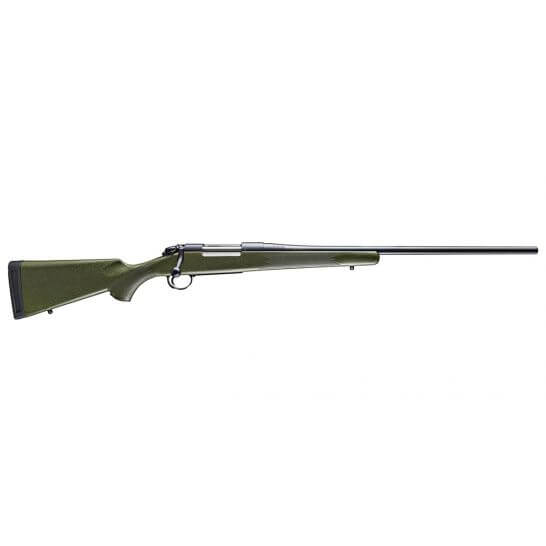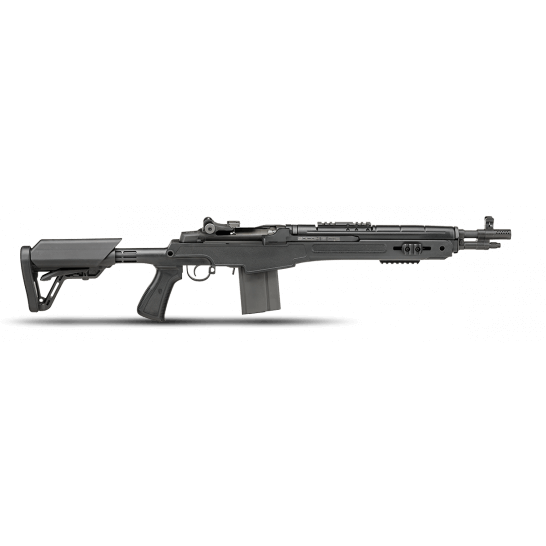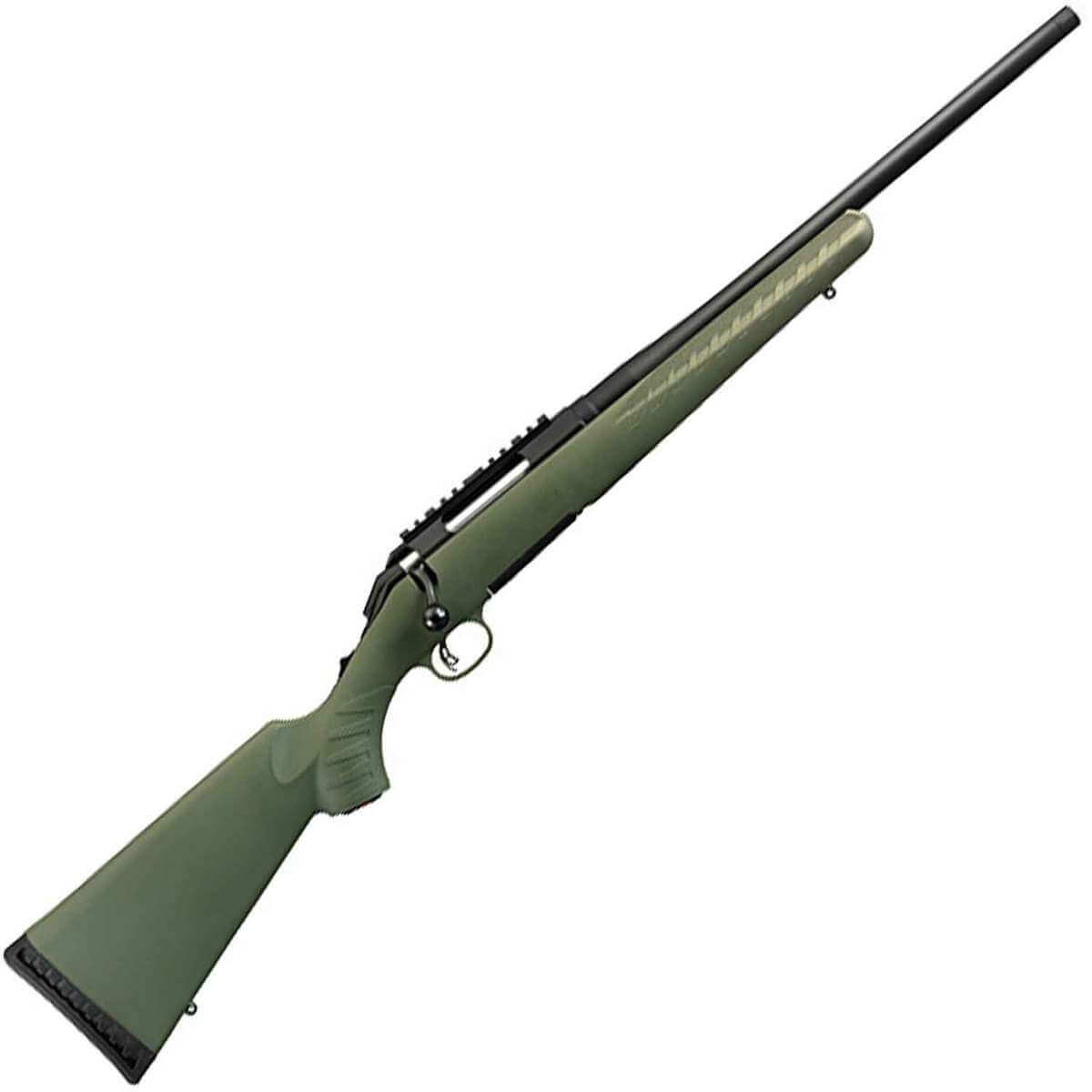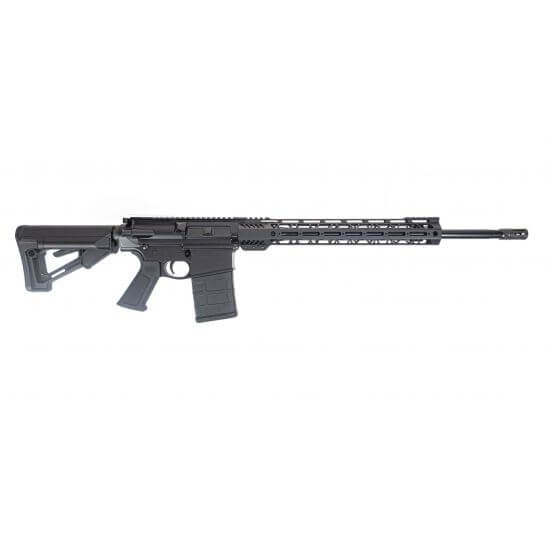This site contains affiliate links. As an Amazon Associate, I earn a commission from qualifying purchases at no extra cost to you. Full Disclosure Here.
There are a number of calibers out there that seem destined to be compared endlessly against each other. One of the most common pairings we get questions about is the .30-06 Springfield vs the .308 Winchester, so we decided to formally compare the two and see what’s what.
These two rounds are used for a lot of the same types of shooting, but they have some key differences that make each one better in certain circumstances and for certain things.
Let’s take a deep dive into these two well-loved cartridges, find out what makes them tick, and see what the real differences are.
Important Background on .30-06 Springfield
The .30-06 has a lot of important history that still influences its modern usage and popularity.
.30-06 Development
The .30-06 Springfield was first introduced in 1906 (hence the “-06” part of the name) by Springfield Armory for use by the United States Military.
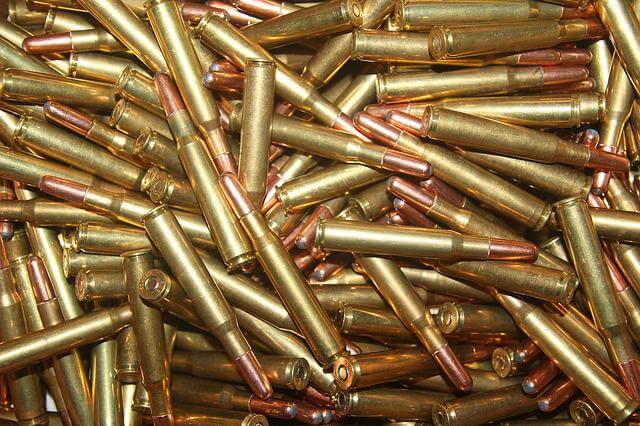
Development had begun several years early on a round to replace the .30-03 cartridge that was the standard service cartridge at the time. The round-nosed .30-03 cartridge was severely lagging behind the pointed Spitzer-style rounds in use across the pond in Europe.
This led to a desire for a Spitzer bullet of our own and spurred the US to develop the “cartridge, ball, caliber .30, Model of 1906” or M1906. This was accomplished by shortening the neck on the existing .30-03 cartridge to allow it to accept a longer 150gr Spitzer bullet.
Existing Springfield M1903 rifles were then modified with a shorter breech and resized chamber to accommodate the new bullet, and from then on the .30-06 was truly off to the races.
.30-06 Use in the Military
Over the next several years, the US military would continue to iterate and improve on the .30-06 cartridge, improving the projectile shape and powder charge, to further improve ballistics and long-range performance.
Following the initial success of the round, the M1 cartridge was developed, which included an improved powder formulation and a heavier projectile with a higher ballistic coefficient. The new 170gr projectiles were also available in armor-piercing and tracer flavors as the years went on.
Weapons development for the round increased as well, with the Browning Automatic Rifle, M1 Garand, and M1917 and M1919 Browning Machine Guns all developed for use with the .30-06 in the following years.
The .30-06 would go on to be used in both World Wars, the Korean War, and stayed in service all the way up to the early parts of the Vietnam War as well, though primarily as a sniper cartridge.
As our main service cartridge, it was supplanted in 1957 by the 7.62x51mm NATO, aka the .308 Winchester.
Important Background on .308 Winchester
The .308 Winchester/7.62x51mm NATO we know and love today has a long history, and while it owes a lot to the .30-06, it has more than proven itself capable of standing on its own as one of the best cartridges ever designed.
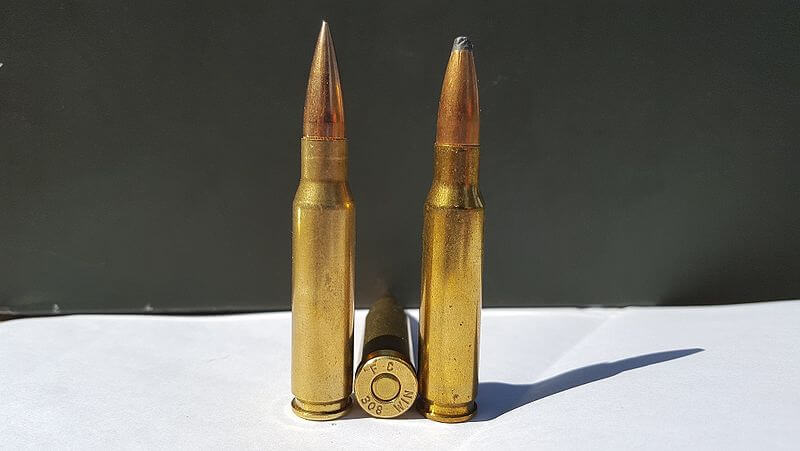
.308 Winchester Development
The .308 Winchester was originally developed in the late 1940s as the T65 cartridge.
This cartridge was developed based on a shorter .30-06 cartridge, with the goal being to use more modern powders to get something close in power to the original .30-06, in a smaller, lighter package.
While it wasn’t adopted by the US Military right away, Winchester saw an opportunity to pitch the round as a civilian hunting round, but it met some initial resistance by folks unwilling to give up their .30-06 guns (especially immediately after the Garand helped win WWII).
Soon however, and with the advent of the M14 being adopted by the US military, the .308 Winchester really caught on in the US, as well as in Europe following the adoption of the 7.62x51mm NATO cartridge, which was just a slightly depressured .308 Win.
.308 Use in the Military
During the Vietnam War, the weight of the round became an issue as soldiers moved further and further from supply, and the recoil of the .308 was a problem in fully-automatic guns fired on the move, or from anything other than a supported prone position.
The amount of lighter-recoiling fully-automatic Russian and Chinese 7.62x39mm weapons wielded by the Vietcong, coupled with the toll of carrying hundreds of .308 rounds through the jungle for sometimes days at a time led to a desire for a lighter, more controllable round.
This eventually gave rise to the development of the .223 Remington and its up-pressured cousin, the .5.56x45mm NATO.
Still, the .308 held on as a sniper and designated marksman weapon, where it is still in heavy use among all NATO militaries to this day. It is also used in several machine gun platforms as well.
Though 6.5 Creedmoor and other rounds are currently challenging the 7.62x51mm NATO for dominance, the .308’s grip on NATO militaries is unlikely to relax soon. In the US alone, it is currently in service in every branch and is the sniper round of choice for all our NATO allies.
.30-06 and .308 Winchester In Modern Civilian Use
These days, both the .30-06 and .308 are beloved by large sections of the civilian population, especially in the US where hunters use them for hunting…basically everything.
The .30-06, in particular, is suitable for hunting anything in North America from whitetail deer all the way up to polar bears (defensively only, of course), and while it has more than enough power to stop a great bear, it still does minimal damage to the meat of even small deer species.
This makes it a great option for a “do it all” rifle for hunters, and I’ve personally used it with great success for my entire shooting career.
The .308 is no slouch either though, and is easily the second most popular short-action cartridge on the planet, after the 5.56. It’s also incredibly popular with hunters, especially deer hunters, and it is beloved by long-range shooters as well. You can also read our comparison between 300 Blackout and 5.56.
.30-06 might have a slightly longer maximum effective range, but .308 has cemented its place as the long-range round of choice for most shooters, especially those who don’t want to switch over to something like 6 or 6.5 Creedmoor, or other more boutique long-range fare.
Personally, my go-to precision rile is 6mm Creedmoor, especially for shooting inside 800 meters, but for general use .308 is still king. It’s cheaper, more readily available, and easy to reload to a variety of different specs that are well understood.
And as far as finding something on the shelf at your local big-box store? You’re going to have a much easier time finding .30-06 and .308 than anything else for big game hunting or long-range shooting.
.30-06 vs .308 Winchester Ballistics
Let’s take a deeper, more technical look at the differences in the actual ballistics of the .30-06 Springfield and the .308 Winchester.
Choosing Between .30-06 Springfield and .308 Winchester
Choosing between .30-06 and .308 comes down to your personal preferences and what your end use case is.
Either one makes for a good multi-purpose round, they’re both good at long ranges, both fairly available, and both effective at hunting a wide variety of game animals. At the end of the day, they’re more alike than they are different.
That said, there are some key differences, which we’ll talk about below. The one thing I would caution you to keep in mind is that this is a question that doesn’t have a strictly right or wrong answer.
I wish I could just tell you to get one or the other, but while I definitely have my own preference, there are pros and cons to each. Let’s go down the list and take a look at some of the key differences between these two rounds.
Recoil
First up, recoil between the two cartridges is so similar that…I really don’t think it matters all that much, except in one key respect.
I should preface this by saying that I’m personally not super recoil sensitive, and I shoot .300 WM and .338 Lapua as often as I can afford it, so some people might notice a pronounced difference where I don’t, but I doubt it.
There are a lot of different loadings out there for these two rounds, with different bullet weights and different powder charges, and so on, but in general, the .30-06 has about 15% more recoil than the .308 with a similarly-sized projectile.
For my money, I don’t think the difference between 20ft/lbs of felt recoil impulse (what hits you in the shoulder) and 22 ft/lbs is noticeable, but the .308 does have a small advantage here.
With that said though, less recoil means faster, easier follow-up shots, and an easier time spotting your own hits and misses through the scope.
The actual felt recoil may be very close, but the extra power of the .30-06 is definitely more noticeable when trying to keep your eyes on the target during the shot. This follow-through period is key for tactical shooters, competitors, and hunters alike.
There’s still not going to be an enormous difference, certainly not like what you’d feel stepping up from .308 to something like .300 WM, but it is definitely enough that you’ll have slightly more difficulty with the .30-06 than the .308.
Where the .308 really wins is in semi-automatic platforms like the AR-10, or even in .308 versions of the M1A. Here you can really notice the difference where it might not be apparent with something like a bolt action because you
Projectile Performance
If you’re looking for a definitive answer in this section, I’ve got some bad news for you…both of these rounds fire the same .308-caliber projectiles.
The one distinction we can draw here is that your typical .308 Winchester is going to top out at a bullet weight of around 200gr while with a .30-06, you can comfortably shoot the heavier 220-240gr projectiles.
If you’re looking to hunt or defend yourself from dangerous large animals like brown bears, this larger projectile size is actually a solid benefit, and can give the edge to the .30-06.
Now, I personally prefer calibers that start with a “.4” for dealing with bears, but between these two, the edge goes to the Springfield. Beyond that, the heavier bullets are mostly a preference thing.
These days, bonded and mono-metal bullets will perform at about the same level regardless of bullet weight, so you are actually better off with a lighter bullet that can get up to a higher velocity.
This makes heavier bullets mostly a preference thing, and only really superior at closer ranges before they start shedding velocity, which they will do at a higher rate than the lighter projectiles.
Other than the really heavy stuff though, you’re shooting the same projectiles, with the same ballistic coefficients, sectional densities, and the same expansion characteristics.
In other words, there really isn’t that much difference here, except in edge cases like shooting the occasional grizzly or polar bear, and if that’s your goal, I’d really suggest moving to something larger than either of these two.
For a “deer hunting in places where you might have to shoot a bear” then the .30-06 is the better choice, so we’ll give it the slight edge in the projectiles category here. Most offerings for both rounds will come topped with something in the 150-180gr range though.
The other thing to keep in mind is that the increased velocity of the .30-06 can make certain projectiles expand or penetrate better, but we’ll talk about that in the next section.
As far as a winner here, we have to call it for the .30-06 because it can handle longer/heavier projectiles. How much the actual mass increase really helps is up for debate. With modern bullets that hold together extremely well, these heavier bullets aren’t as necessary.
Lighter mono-mental bullets will have a higher velocity, and still hold together just as well when striking bone and other hard surfaces, so you’re better off with something in the 150-180gr range with more modern projectiles.
With older, more inexpensive projectiles though, those heavier jacketed projectiles will carry more energy further into the target, however. So if you aren’t shooting expensive, top-tier ammo, then the larger pills do still have merit.
Velocity
Velocity is a key factor for long-range shooting as well as general hunting, and a higher velocity will generally make it easier to put rounds on target. Higher velocity means less drop, less drift due to wind, and better performance when impacting a soft target.
So which one of these rounds has a higher velocity?
Well, I picked the 10 most popular loadings I could find from each round and came up with the following data. This gives us some average velocities.
| Distance (Yards) | .30-06 Velocity in ft/s | .308 Win Velocity in ft/s |
| 0 | 2886 | 2755 |
| 100 | 2641 | 2589 |
| 300 | 2404 | 2368 |
| 300 | 2199 | 2179 |
| 400 | 2051 | 2006 |
| 500 | 1855 | 1799 |
Now, these are just averages across a number of rounds that I just picked from my favorite retailer’s list of most popular products, but it does give us a good basis for comparison.
What we see here is that while the .30-06 clearly has the edge when it comes to velocity, its not by much. This is just a measure of factory velocities of popular off-the-shelf ammo, so we can’t use it as an overall judgment, just for a generalization.
In fact, many .308 rounds will actually have a greater velocity than roughly equivalent .30-06 ammo, depending on how they’re loaded.
Specs-wise, .308 Winchester is actually capable of being loaded to a slightly higher pressure, which can help make up some ground on the velocity front. Then again, the .30-06 has more case room, which is what helps the .30-06 stay on top in most cases.
As far as handloading goes, you can definitely get overall higher velocities in a .30-06 than a .308, but you’ll have to do some fine-tuning of your own.
Generally speaking, a 150gr projectile out of a .30-06 with an 18” barrel at about 2850fps, and a .308 can send the same size projectile down a barrel of the same length at about 2713fps.
The one area where this will actually make a noticeable difference is with bullet expansion at closer ranges. In particular, many modern mono-metal projectiles designed for hunting require some significant velocity to expand properly.
For example, 168gr Barnes TSX mono-metal bullet will require 1,985fps of velocity to expand as much as possible. Anything less than that, and the bullet won’t open up as much as it could.
At closer ranges, both the .308 and the .30-06 can push a 168gr bullet to those speeds quite easily, but the point where they fall below that speed is a little different, with the .30-06 maintaining that speed to about 400 yards, vs 350 for the .308.
This illustrates just how much the extra velocity of the .30-06 can help, but the difference between 100% expansion and 95% expansion on a bullet like this is going to be incredibly negligible. That deer you shot isn’t going to tell a difference, I promise you that.
Still, the .308 is a measurable slower, even if the difference doesn’t have much practical effect on real-world shooting, especially when it comes to hunting, but the velocity battle still goes to the .30-06.
How much this extra velocity actually helps may be up for debate, and I don’t think 100 extra fps or so is going to make much real difference, but it does have some benefits, especially at long range.
And speaking of long-range…
Long-Range Performance & Accuracy
In theory, .30-06 should have better long-range performance than the .308 higher velocity ceiling. In some ways, this holds true.
A .30-06 will have slightly less drop than a .308 will, making it a better option for those thousand-yard shots, and it will also stay supersonic about 10% longer.
The distance at which a round maintains supersonic velocity is important because slowing down to a subsonic speed can cause disruption to the round’s ballistic trajectory and makes it more susceptible to the simple physics of gravity and air resistance.
All of this combines to make the .30-06 marginally better at longer ranges, but is it enough to offset the extra expense of both the rounds themselves and the corresponding rifles?
For my money, if you’re just chasing long-range performance, there are better rounds out there than either of these. Something like Cmm CM, 6.5 CM, .300 PRC, or .300 WM will serve you better.
Reloading
So far, we’ve seen that the .30-006 and .308 Win are pretty similar. In terms of reloading though, we actually have a pretty clear winner. The .30-06 Springfield has a case capacity of 68gr, while the .308 tops out at 56gr.
The .30-06’s longer case (2.49in to the .308’s 2.015in) makes it much more forgiving in terms of reloading for higher velocity. You can also more comfortably shoot longer and heavier projectiles, which gives you a good bit more variety when it comes to handloading.
Other than heavy 200gr+ projectiles and the extra case room though, you’re still slinging the same projectiles at similar enough velocities that there’s not an enormous difference either way.
Still, if you’re looking for something to tinker with at the reloading bench, the .30-06 is undoubtedly more versatile and has more room (literally) for experimentation and tinkering.
You get 18% more case capacity to play around with, and can safely get up to 150fps more velocity. You can also load larger projectiles. Case pressure limits are the same though at 62,000psi, so keep that in mind.
Terminal Performance & Hunting
When it comes to hunting, we have a clear winner, at least in terms of just the rounds themselves. The .30-06 can stabilize larger/heavier projectiles, and it has more velocity when loaded with projectiles of the same size.
On average, based on my extremely unscientific
This translates into slightly better penetration and expansion in soft tissue, which makes for a larger wound channel, which means you’re more likely to have an animal down quickly and ethically.
Round for round, it’s hard to argue with the .30-06 as the superior choice for hunting, especially given its proven record of success taking larger game. Not that we recommend it, but hunters have taken every game species on the planet with the .30-06, elephants included.
The .308 has an excellent track record as a hunting cartridge as well, but it simply doesn’t have the energy to reliably take down larger game species the way the .30-06 does.
The one place the .308 wins is when it comes to semi-automatic platforms used for things like hog hunting or other dangerous game hunting. There just aren’t as many modern options for a semi-auto .30-06 as there are for the .308.
You can still get something like an M1A but it’s more expensive and less efficient than say, an AR-10 or surplus rifle like an FN FAL.
On a round vs round basis, the .30-06 is definitely more versatile though, so we have to give this one to the Springfield.
Ammo Price

Another area where we have a clear winner! Winchester .308, assuming we’re not currently in a panic-buy situation where there’s no ammo to be found anywhere, will usually run about 30% cheaper than equivalent-quality .30-06.
In some cases, .308 Win can be even cheaper, but this is typically only if you can snag a really good deal on some surplus ammo.
In general though, the simple fact that .30-06 ammo takes more propellant to charge, and more brass to make the case means that it’s always going to be more expensive for equivalent rounds.
Now, there are absolutely some high-end match rounds for .308 that will be cheaper than standard .30-06 soft points. That said, for rounds of roughly equivalent quality, you’ll definitely pay less for .308 ammo.
In fact, if you’re looking for something that you can buy cheap and stack deep, .308 is definitely the best full-sized rifle cartridge to go with.
The fact that 7.62×51 NATO (which is interchangeable with the .308 Win) is the second most popular centerfire rifle round on the planet really works in our favor here and helps keep the cost of the ammo down.
You can even get surplus NATO ammo that will be both high-quality, and much, much cheaper than equivalent .30-06 ammo.
For these reasons, we’ve gotta give this one to the .308. It’s cheaper in almost every way and is one of the more affordable large rifle calibers on the planet. The fact that it’s made by just about every ammo manufacturer on Earth certainly doesn’t hurt either.
Available Rifles
When it comes to rifles, the situation is actually very similar. These rounds have been out for a long time and hold a special place in the hearts and minds of many shooters, so manufacturers are definitely still strongly supporting them with new rifles.
But there’s still a clear winner.
The .308, thanks to its short-action size, has a much greater variety of rifles chambered for it, and equivalent quality and styles of rifles are cheaper than their .30-06 brethren.
With a .308, you’ll pay 15-20% less for an equivalent rifle in most cases, and because the .308 is a NATO cartridge in the form of the 7.62×51 NATO, rifles chambered for it tend to be more popular overseas, especially in Europe where it’s easily the most common large rifle cartridge.
This means that companies like CZ, Mauser, Tikka, Merkel, Sako, and other EU-based manufacturers are much more likely to produce a rifle in .308 than they are .30-06.
There’s also the fact that there are a huge variety of semi-automatic and even fully-automatic .308 rifles out there, including but not limited to the: AR-10, HK91, FN FAL, SCAR-H, TAVOR 7, and probably a dozen others.
If you want a semi or fully-automatic .30-06, you can either buy a transferable BAR from WWII for roughly the same price as a new 4×4 pickup truck, a semi-auto clone if you can find one in stock, or a variation of the M1 Garand or M1A.
That’s…about it.
This gives the .308 the clear victory when it comes to the rifles available to the average shooter, both in terms of variety and on the value side of things as well.
Best .30-06 Rifles
Now, let’s take a look at some .30-06 rifles to get an idea of what’s out there. There are dozens more great options than just these four, but I wanted to highlight some that are popular and/or personal favorites.
Bergara B-14 Hunter
First, the Bergara B-14 Hunter. This is a fairly mid-range hunting rifle and is a good example of what you’re likely to find once you step out of the budget realm of .30-06 bolt-actions. It has a 4140 CrMo steel barrel and is drilled and tapped for a scope mount.
It is built on Bergara’s excellent B-14 action and is silky smooth through every part of running the bolt to chamber a new round.
As is typical for most bolt-action .30-06 rifles it has a 4+1 capacity and a 24” barrel.
Accuracy-wise, this is a ½ MOA gun all day, and is more than accurate enough for hunting, and it isn’t a bad choice for ringing steel and doing a bit of target shooting too if that’s something you’re thinking about doing.
If you’re looking for an awesome bolt-action rifle that won’t break the bank, but still brings in a number of premium features that set it apart from many of the other sub-$600 rifles.
Springfield M1A SOCOM CQB
Next, we have the best option if you’re looking for semi-automatic capability in .30-06, the Springfield Armory M1A SOCOM CQB. This is basically a magazine-fed version of the legendary M1 Garand.
It has a 16.5” barrel, a 10-round magazine, a ghost ring rear sight with a tritium front post, and rails at 3, 6, and 9 o’clock on the forend for you to mount whatever lights, lasers, or what have you depending on what you’re using the rifle for.
This is a great option if you want that classic M1 styling, or just want semi-auto capability with your .30-06. This is a great hog hunting gun and is light enough to be a pretty handy ranch rifle as well for general shooting.
The longer-barrelled versions are also some of the most accurate .30-06 rifles that I’ve tested, and I’ve even seen some at Precision Rifle Series and NRA High Power matches.
Best .308 Rifles
Let’s turn our attention to .308 rifles now. Again, there are dozens of other great .308 rifles out there, this is just a quick look at a couple of options to give you an idea of what’s out there.
Ruger American Predator
First up, we have one of my favorite .308 hunting rifles, the Ruger American Predator. It features an 18” barrel, Ruger’s excellent American action, and a heavy bull barrel with a 1:10” twist-rate.
Most stock options are synthetic, which helps keep the rifle affordable, and all come with Ruger’s awesome Marksman Adjustable Trigger that features a safety-blade, and one of the crispest breaks you’ll find on any rifle in this price bracket.
Seriously, if you’re a trigger snob like I am, this is a great way to get something solidly in the high-performance category without having to spend a fortune on a high-end rifle, or upgrade your trigger after you purchase.
This is a sub-MOA gun all day right out of the box, and is by far the most accurate rifle in it’s price bracket by a pretty considerable margin. It’s an excellent value, and one I have recommended for years now.
Palmetto State Armory PA-10
Our next pick is the Palmetto State Armory PA-10, which has quickly become one of the most popular semi-automatic .308s on the market, and one of my personal favorites as well.
It’s a standard AR-10 platform, and it features a 20” 4140 Chrome Moly Vanadium barrel, M-Lok free-float rail, and a rifle-length gas system. It is surprisingly accurate for the price, and printed some nice sub-MOA groups in my rather extensive testing with it.
It also comes with an adjustable gas block, a tool craft 9310 steel bolt assembly, and beefed up extractor springs to help prevent one of the more common failures on this type of rifle. The upper and lower are both lightweight, ultra-strong 7075 T-6 aluminum.
It also comes with an excellent Geissele Super Semi-Auto Enhanced trigger that makes it great for competition
When To Choose One Over The Other
So, with all of that having been said, when is it better to go with the .30-06 and when is it better to stick with the .308?
It really depends on what you’re trying to accomplish, and what type of shooting you’re doing.
If you’re a hunter leaning towards hunting larger game and hunting at longer ranges, then the .30-06 is probably a little bit better for you. It’s slightly more versatile and has a better chance against larger types of game.
On the other hand, if you’re in a position where you need to send lead down range faster, then the short-action .308 is a much better choice. Not only do you have less distance to manipulate the bolt, but the short-action nature of the cartridge means it plays well with semi-autos.
Sure, you have the M14 and the MIA for semi-auto .30-06 goodness, but the extra length off the .30-06 means that it doesn’t really play well with other semi-automatic platforms like the AR-10. The .308 however, definitely does.
Because of this, for more tactical style shooting or for hunting say, wild hogs, the .308 is definitely the one to go with. The ability to send a second (or third or fourth) round quickly can be vital when hog hunting, or in some kind of defensive situation.
If you’re looking to fire one shot and deliver maximum energy to the target, especially if that target weighs half a ton or more and is bear-shaped, then .30-06 is the way to go. You can get more velocity and a larger projectile, which translates into more energy transferred to the target.
This hopefully means you’re more likely to end up with a dead bear than a dead you.
The other thing to consider is that the .308 is an inherently cheaper round to buy and the associated rifles are cheaper as well. It’s 90% of the performance at 75% the price, generally speaking, which may make all the difference to some folks.
Finally, if you’re really interested in handloading and what something to experiment with, then the .30-06 is going to be the better option because it has that higher case capacity and ability to handle longer and heavier projectiles more comfortably.
Wrapping Up
The biggest takeaway from all of this though is that these rounds are more alike than they are different, and there isn’t really a “wrong” choice here. One might be less optimal for your intended shooting situation, but neither one will let you down.
Both are solid and reliable and have enjoyed decades of support from the shooting sports community. I’ve personally used both for about twenty years now, and I happen to love them.
Either one would make a perfectly good choice for hunting or target shooting, and which one is truly “better” is going to come down to shooter preference and exactly what you’re trying to accomplish, as well as your budget.
At the end of the day, neither the .30-06 nor the .308 is going away anytime soon, and we should be grateful for that because they’re both awesome rounds with lots of life left in them.


